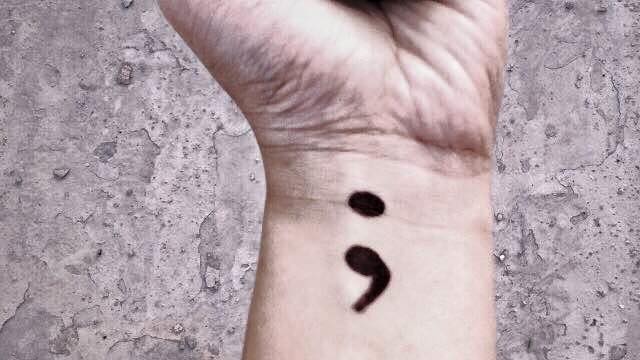The Inspiring Story Behind the Semicolon Tattoo
If your Facebook feed is anything like mine, you’ve probably noticed a few friends and family members posting photos of themselves at nearby tattoo parlors getting inked with a simple grammatical symbol: the semicolon.
Chances are your friends and family aren’t fanatical grammar sticklers (although they could be). Instead, these tattoos have a more inspiring purpose: to raise awareness and support for mental illness and suicide prevention.
The trend started back in 2013 with one amazing woman: Amy Bleuel, who founded Project Semicolon. The choice of a semicolon to represent the nonprofit organization wasn’t an accident. The semicolon represents when an author could have chose to end their sentence, but instead, they kept on going.
Herself a victim of rape, abuse, bullying and suicidal thoughts, Bleuel was driven to support others who felt the same way. She wanted to give hope to others who had none. Sadly, Bleuel died by suicide in 2018, although her mission still lives on with countless others across the country who’ve picked up the torch on her behalf.
Even celebrities are joining in the movement. Selena Gomez, executive producer of the Netflix series “13 Reasons Why,” and case members Alisha Boe and Tommy Dorfman recently got matching semicolon tattoos.
You can read Dorfman’s inspiring story in a caption he posted on Instagram:
https://www.instagram.com/p/BSsBAQjgcq3/?utm_source=ig_embed
There’s still plenty of work to be done. According to the National Institute of Mental Health, almost 45,000 Americans die by suicide every year. It’s currently the 10th leading cause of death in America, and rates have been ticking ever upward over the last 15 years. About 4 percent of Americans every year have suicidal thoughts.
It’s a huge and growing problem, and that’s why the semicolon tattoos began to take off. They’re a simple, affordable and hugely symbolic tattoos that can be done quickly, often even without a prior appointment. For some people, it’s a personal reminder of their own struggles, while for others, it’s a show of solidarity with friends, family or even strangers who have struggled with suicide.
For Kelly DeBie, who has two semicolon tattoos and blogs about her struggles with anxiety, postpartum depression, and PTSD at DeBie Hive, it’s both.
“My first one is on my wrist, right where I can see my pulse,” she says.
Her second is “in a significant place on my arm, where the inpatient access number was written for a family member.”
Some people choose to place tattoos where others can visibly see them at all times, while others choose more private places for more private meanings. They can be as simple as the two marks that make up the semicolon alone, or they can be incorporated into other designs, such as butterflies, hearts or flowers. There is no right or wrong tattoo design or placement, but one thing’s for sure: each one is deeply personal to its owner.
“They remind me of how much I have survived, of how far I have come, of why I’m still fighting to stay here,” says DeBie. “The second especially reminds me to stay vigilant, keep my eyes and ears and heart open. They urge me to keep talking and keep checking on others. They open up conversations, and let other people know that they can come to me in confidence.”
Breaking the stigma around mental illness is a huge reason for the tattoo’s popularity. Far too many people suffer in silence from mental illness and suicidal thoughts. Even the wording we use to describe suicide — “commit” suicide, as if we’re blaming the victims — can be a problem. But by raising awareness and telling people in words or, in this case, symbols, that they’re not alone and they’re not a bad person, it can hopefully spur people to reach out for help when they need it.
“It took me a long time to admit my issues and confront my struggles, but I came to realize it’s the act of talking that keeps me here, and my openness might help other people,” says DeBie. “The only way the stigma surrounding mental health goes away is for us to be okay with talking about these conditions. Dragging them out into the light and stripping them of their power. We all need help sometimes.”
If you are having thoughts of suicide, please don’t hesitate to reach out to counselors at the National Suicide Prevention Line at 1-800-273-8255. You can also get immediate help from the Crisis Text Line by texting HOME to 741741. Finally, if you think a loved one may be thinking about suicide, you can learn the warning signs and how you can help them and others at #BeThe1To.


